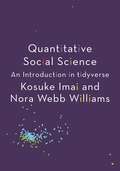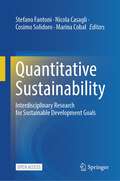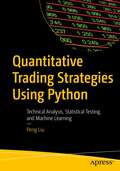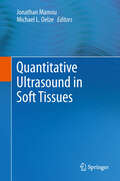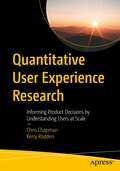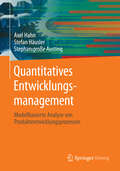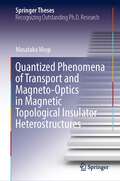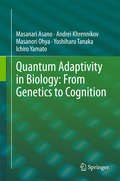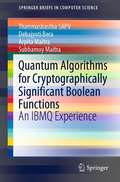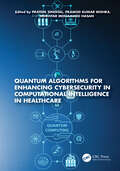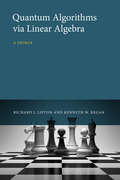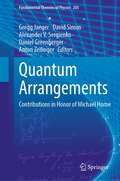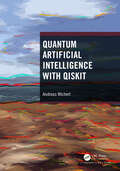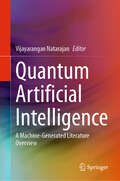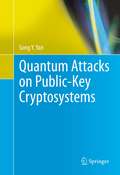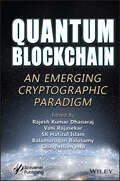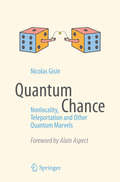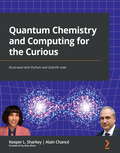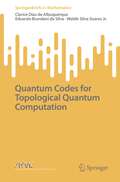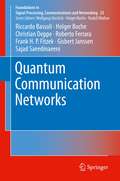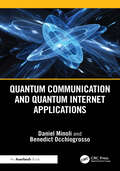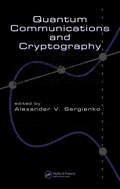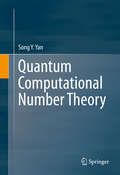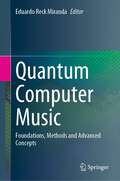- Table View
- List View
Quantitative Social Science: An Introduction in tidyverse
by Kosuke Imai Nora Webb WilliamsA tidyverse edition of the acclaimed textbook on data analysis and statistics for the social sciences and allied fieldsQuantitative analysis is an essential skill for social science research, yet students in the social sciences and related areas typically receive little training in it. Quantitative Social Science is a practical introduction to data analysis and statistics written especially for undergraduates and beginning graduate students in the social sciences and allied fields, including business, economics, education, political science, psychology, sociology, public policy, and data science. Proven in classrooms around the world, this one-of-a-kind textbook engages directly with empirical analysis, showing students how to analyze and interpret data using the tidyverse family of R packages. Data sets taken directly from leading quantitative social science research illustrate how to use data analysis to answer important questions about society and human behavior.Emphasizes hands-on learning, not paper-and-pencil statisticsIncludes data sets from actual research for students to test their skills onCovers data analysis concepts such as causality, measurement, and prediction, as well as probability and statistical toolsFeatures a wealth of supplementary exercises, including additional data analysis exercises and programming exercisesOffers a solid foundation for further studyComes with additional course materials online, including notes, sample code, exercises and problem sets with solutions, and lecture slides
Quantitative Sustainability: Interdisciplinary Research for Sustainable Development Goals
by Nicola Casagli Stefano Fantoni Cosimo Solidoro Marina CobalThis open access book focuses on how scientific methodologies can help industrial managers, entrepreneurs and policymakers handle the 17 Sustainable Development Goals in an efficient and realistic way. It also offers an operative scheme for scientists to overcome their discipline barriers. Is interdisciplinarity an intrinsic research value or is it merely instrumental for handling the increasing flux of open problems that sustainability poses to science?Can these problems of sustainability be solved with what the authors already know? Is it just a matter of having the right people at the table and giving them sufficient resources, or is it something more? Is meeting the needs of the present without compromising those of future generations a scientific definition of sustainable development? Questions similar to those posed in the sixties regarding complexity must be asked about sustainability today. In addition, the new data science includes powerful tools for making novel quantitative predictions about future sustainability indicators, an open problem that the book discusses. This book is primarily addressed to Ph.D. students, postdocs and senior researchers in the Life and Hard Science (LHS) and Social Sciences and Humanities (SSH) disciplines, as well as professionals of the primary, secondary and tertiary industrial sectors.
Quantitative Trading Strategies Using Python: Technical Analysis, Statistical Testing, and Machine Learning
by Peng LiuBuild and implement trading strategies using Python. This book will introduce you to the fundamental concepts of quantitative trading and shows how to use Python and popular libraries to build trading models and strategies from scratch. It covers practical trading strategies coupled with step-by-step implementations that touch upon a wide range of topics, including data analysis and visualization, algorithmic trading, backtesting, risk management, optimization, and machine learning, all coupled with practical examples in Python.Part one of Quantitative Trading Strategies with Python covers the fundamentals of trading strategies, including an introduction to quantitative trading, the electronic market, risk and return, and forward and futures contracts. Part two introduces common trading strategies, including trend-following, momentum trading, and evaluation process via backtesting. Part three covers more advanced topics, including statistical arbitrage using hypothesis testing, optimizing trading parameters using Bayesian optimization, and generating trading signals using a machine learning approach. Whether you're an experienced trader looking to automate your trading strategies or a beginner interested in learning quantitative trading, this book will be a valuable resource. Written in a clear and concise style that makes complex topics easy to understand, and chock full of examples and exercises to help reinforce the key concepts, you’ll come away from it with a firm understanding of core trading strategies and how to use Python to implement them.What You Will LearnMaster the fundamental concepts of quantitative tradingUse Python and its popular libraries to build trading models and strategies from scratchPerform data analysis and visualization, algorithmic trading, backtesting, risk management, optimization, and machine learning for trading strategies using PythonUtilize common trading strategies such as trend-following, momentum trading, and pairs tradingEvaluate different quantitative trading strategies by applying the relevant performance measures and statistics in a scientific manner during backtestingWho This Book Is ForAspiring quantitative traders and analysts, data scientists interested in finance, and researchers or students studying quantitative finance, financial engineering, or related fields.
Quantitative Ultrasound in Soft Tissues
by Jonathan Mamou Michael L. OelzeDue to parallel advances in signal processing and computer hardware in the last 15 years, quantitative ultrasound techniques have reached maturity, allowing for the construction of quantitative maps or images of soft tissues. This book will focus on 5 modern research topics related to quantitative ultrasound of soft tissues: - Spectral-based methods for tissue characterization, tissue typing, cancer detection, etc. ; - Envelope statistics analysis as a means of quantifying and imaging tissue properties; - Ultrasound elastography for quantifying elastic properties of tissues (several clinical ultrasound scanners now display elastography images); - Scanning acoustic microscopy for forming images of mechanical properties of soft tissues with micron resolution (desktop size scanners are now available); and - Ultrasound computer tomography for breast cancer imaging (new ultrasound tomography systems have been developed and are currently under evaluation clinically).
Quantitative User Experience Research: Informing Product Decisions by Understanding Users at Scale
by Chris Chapman Kerry RoddenThis book is your definitive guide to the rapidly growing role of Quantitative User Experience (Quant UX) Research in product development. The book provides an overview of the skills you need on the job, presents hands-on projects with reusable code, and shares advice on starting and developing a career. The book goes beyond basic skills to focus on what is unique to Quant UX. The authors are two of the most widely recognized practitioners in Quant UX research, and this book shares insights from their combined decades of experience. Organizations today have more data about user needs and behaviors than ever before. With this large-scale data, Quant UX researchers work to understand usage patterns, measure the impact of design changes, and inform strategic decisions. In the Quant UX role, interdisciplinary researchers apply analytical skills to uncover user needs, inform engineering and design, answer strategic business questions, and optimize software and hardware products for human interaction. This book provides guidance around customer satisfaction surveys, understanding user behavior from log analysis, and the statistical methods that are commonly used to assess user outcomes. What You Will LearnDiscover the role of Quantitative User Experience (Quant UX) researchUnderstand how Quant UX research differs from other disciplines such as data sciencePlan common research projects and know how to achieve successPosition Quant UX activities in product development, engineering, and UX organizationsApply the HEART framework to measure user experience outcomesEvaluate your skills and potential to be hired as a Quant UX researcherKnow what to expect during job interviewsFind examples of common Quant UX projects with shared R code and data setsWho This Book Is ForPractitioners and managers who seek a comprehensive guide to the new field of Quantitative User Experience Research. Readers will understand the Quant UX role, build research skills, find examples of hands-on code and analyses, learn about UX organizations and stakeholders, and receive advice on job interviews and career paths. Data scientists, social scientists, and other researchers will learn how their skills transfer to Quant UX, where they can help teams build better, more successful products.
Quantitatives Entwicklungsmanagement
by Axel Hahn Stephan Große Austing Stefan HäuslerDie Produktentwicklung ist der dynamischste und am schwersten zu beherrschende Prozess in Industrieunternehmen. Prozessreifegradmodelle wie CMMI erfordern dazu quantitative Methoden als Werkzeug des Entwicklungsmanagements. Mit der modellgetriebenen Entwicklung steht eine Datenbasis für eine durchgehende quantitative Analyse zur Verfügung. Modellanalysen erlauben eine prozessbegleitende Qualitätsmessung und die Bestimmung der Produktkomplexität und des Entwicklungsfortschritts. Das Buch stellt bestehende Methoden des quantitativen Entwicklungsmanagements zur Entscheidungsunterstützung auf operativer und strategischer Ebene vor. Die Autoren zeigen, wie die modellgetriebene Entwicklung zur Analyse der erreichten Ergebnisse genutzt werden kann, etwa zur Bewertung von Methoden, Werkzeugen sowie zur Prozess- oder Projektanpassung.
Quantized Phenomena of Transport and Magneto-Optics in Magnetic Topological Insulator Heterostructures (Springer Theses)
by Masataka MogiThis book presents experimental studies on emergent transport and magneto-optical properties in three-dimensional topological insulators with two-dimensional Dirac fermions on their surfaces. Designing magnetic heterostructures utilizing a cutting-edge growth technique (molecular beam epitaxy) stabilizes and manifests new quantization phenomena, as confirmed by low-temperature electrical transport and time-domain terahertz magneto-optical measurements. Starting with a review of the theoretical background and recent experimental advances in topological insulators in terms of a novel magneto-electric coupling, the author subsequently explores their magnetic quantum properties and reveals topological phase transitions between quantum anomalous Hall insulator and trivial insulator phases; a new topological phase (the axion insulator); and a half-integer quantum Hall state associated with the quantum parity anomaly. Furthermore, the author shows how these quantum phases can be significantly stabilized via magnetic modulation doping and proximity coupling with a normal ferromagnetic insulator. These findings provide a basis for future technologies such as ultra-low energy consumption electronic devices and fault-tolerant topological quantum computers.
Quantum Adaptivity in Biology: From Genetics to Cognition
by Andrei Khrennikov Masanari Asano Masanori Ohya Yoshiharu Tanaka Ichiro YamatoThis book examines information processing performed by bio-systems at all scales: from genomes, cells and proteins to cognitive and even social systems. It introduces a theoretical/conceptual principle based on quantum information and non-Kolmogorov probability theory to explain information processing phenomena in biology as a whole. The book begins with an introduction followed by two chapters devoted to fundamentals, one covering classical and quantum probability, which also contains a brief introduction to quantum formalism, and another on an information approach to molecular biology, genetics and epigenetics. It then goes on to examine adaptive dynamics, including applications to biology, and non-Kolmogorov probability theory. Next, the book discusses the possibility to apply the quantum formalism to model biological evolution, especially at the cellular level: genetic and epigenetic evolutions. It also presents a model of the epigenetic cellular evolution based on the mathematical formalism of open quantum systems. The last two chapters of the book explore foundational problems of quantum mechanics and demonstrate the power of usage of positive operator valued measures (POVMs) in biological science. This book will appeal to a diverse group of readers including experts in biology, cognitive science, decision making, sociology, psychology, and physics; mathematicians working on problems of quantum probability and information and researchers in quantum foundations.
Quantum Algorithms for Cryptographically Significant Boolean Functions: An IBMQ Experience (SpringerBriefs in Computer Science)
by Subhamoy Maitra Tharrmashastha SAPV Debajyoti Bera Arpita MaitraThis book is a timely report of the state-of-the-art analytical techniques in the domain of quantum algorithms related to Boolean functions. It bridges the gap between recent developments in the area and the hands-on analysis of the spectral properties of Boolean functions from a cryptologic viewpoint. Topics covered in the book include Qubit, Deutsch–Jozsa and Walsh spectrum, Grover’s algorithm, Simon’s algorithm and autocorrelation spectrum. The book aims at encouraging readers to design and implement practical algorithms related to Boolean functions. Apart from combinatorial techniques, this book considers implementing related programs in a quantum computer. Researchers, practitioners and educators will find this book valuable.
Quantum Algorithms for Enhancing Cybersecurity in Computational Intelligence in Healthcare
by Pramod Kumar Mishra Singhal, Edited by Prateek Mokhtar Mohammed HasanThis book explores the exciting field of quantum computing, which is changing how we approach computation. It covers the basics, cybersecurity aspects, advanced machine learning techniques, and the many ways quantum computing can be used. Quantum computing is much more powerful than traditional computing. The book starts by explaining the core concepts like qubits, quantum gates, superposition, entanglement, quantum memory, and quantum parallelism. One important area is how quantum computing can improve machine learning for cybersecurity. It can handle huge amounts of data and find complex patterns faster than regular computers. This is especially useful for finding cyber threats in real time, such as spotting unusual activity in healthcare networks that might mean a security breach. Quantum machine learning can help healthcare organizations better defend against advanced cyberattacks that try to steal patient data. The book also looks at how quantum computing is changing cybersecurity itself.It discusses quantum cryptography, post-quantum cryptography, and secure communication, explaining how quantum computing is leading to new ways of encrypting data, detecting threats, and protecting information. Beyond cybersecurity, the book shows how quantum computing impacts many other fields, such as medicine, finance, materials science, and logistics. It is poised to revolutionize artificial intelligence (AI) in healthcare and many other sectors. Because quantum computing is constantly developing, with discoveries and new applications happening all the time, this book brings together researchers from universities and industries to share their latest findings. It aims to help shape the future of this technology. The book offers a solid foundation, detailed explanations of advanced techniques, and a fascinating look at how quantum computing is being used in the real world. As quantum computing becomes easier to access through new tools and cloud platforms, this book hopes to inspire new research in AI and spark innovative applications that were previously thought impossible.
Quantum Algorithms via Linear Algebra: A Primer
by Richard J. Lipton Kenneth W. ReganQuantum computing explained in terms of elementary linear algebra, emphasizing computation and algorithms and requiring no background in physics.This introduction to quantum algorithms is concise but comprehensive, covering many key algorithms. It is mathematically rigorous but requires minimal background and assumes no knowledge of quantum theory or quantum mechanics. The book explains quantum computation in terms of elementary linear algebra; it assumes the reader will have some familiarity with vectors, matrices, and their basic properties, but offers a review of all the relevant material from linear algebra. By emphasizing computation and algorithms rather than physics, this primer makes quantum algorithms accessible to students and researchers in computer science without the complications of quantum mechanical notation, physical concepts, and philosophical issues.After explaining the development of quantum operations and computations based on linear algebra, the book presents the major quantum algorithms, from seminal algorithms by Deutsch, Jozsa, and Simon through Shor's and Grover's algorithms to recent quantum walks. It covers quantum gates, computational complexity, and some graph theory. Mathematical proofs are generally short and straightforward; quantum circuits and gates are used to illuminate linear algebra; and the discussion of complexity is anchored in computational problems rather than machine models. Quantum Algorithms via Linear Algebra is suitable for classroom use or as a reference for computer scientists and mathematicians.
Quantum Arrangements: Contributions in Honor of Michael Horne (Fundamental Theories of Physics #203)
by David Simon Gregg Jaeger Anton Zeilinger Alexander V. Sergienko Daniel GreenbergerThis book presents a collection of novel contributions and reviews by renowned researchers in the foundations of quantum physics, quantum optics, and neutron physics. It is published in honor of Michael Horne, whose exceptionally clear and groundbreaking work in the foundations of quantum mechanics and interferometry, both of photons and of neutrons, has provided penetrating insight into the implications of modern physics for our understanding of the physical world. He is perhaps best known for the Clauser-Horne-Shimony-Holt (CHSH) inequality. This collection includes an oral history of Michael Horne's contributions to the foundations of physics and his connections to other eminent figures in the history of the subject, among them Clifford Shull and Abner Shimony.
Quantum Artificial Intelligence with Qiskit
by Andreas WichertQuantum Artificial Intelligence (QAI) is a new interdisciplinary research field that combines quantum computing with Artificial Intelligence (AI), aiming to use the unique properties of quantum computers to enhance the capabilities of AI systems. Quantum Artificial Intelligence with Qiskit provides a cohesive overview of the field of QAI, providing the tools for readers to create and manipulate quantum programs on devices as accessible as a laptop computer. Introducing symbolical quantum algorithms, sub-symbolical quantum algorithms, and quantum Machine Learning (ML) algorithms, this book explains each process step by step with associated Qiskit listings. All examples are additionally available for download at https://github.com/andrzejwichert/qai. Allowing readers to learn the basic concepts of quantum computing on their home computers, this book is accessible to both the general readership as well as students and instructors of courses relating to computer science and AI.
Quantum Artificial Intelligence: A Machine-Generated Literature Overview
by Vijayarangan NatarajanThis book presents the result of an innovative challenge, to create a systematic literature overview driven by machine-generated content. Questions and related keywords were prepared for the machine to query, discover, collate and structure by Artificial Intelligence (AI) clustering. The AI-based approach seemed especially suitable to provide an innovative perspective as the topics are indeed both complex, interdisciplinary and multidisciplinary, for example, climate, planetary and evolution sciences. Springer Nature has published much on these topics in its journals over the years, so the challenge was for the machine to identify the most relevant content and present it in a structured way that the reader would find useful. The automatically generated literature summaries in this book are intended as a springboard to further discoverability. They are particularly useful to readers with limited time, looking to learn more about the subject quickly and especially if they are new to the topics. Springer Nature seeks to support anyone who needs a fast and effective start in their content discovery journey, from the undergraduate student exploring interdisciplinary content to Master- or PhD-thesis developing research questions, to the practitioner seeking support materials, this book can serve as an inspiration, to name a few examples. It is important to us as a publisher to make the advances in technology easily accessible to our authors and find new ways of AI-based author services that allow human-machine interaction to generate readable, usable, collated, research content.
Quantum Attacks on Public-Key Cryptosystems
by Song Y. YanThe cryptosystems based on the Integer Factorization Problem (IFP), the Discrete Logarithm Problem (DLP) and the Elliptic Curve Discrete Logarithm Problem (ECDLP) are essentially the only three types of practical public-key cryptosystems in use. The security of these cryptosystems relies heavily on these three infeasible problems, as no polynomial-time algorithms exist for them so far. However, polynomial-time quantum algorithms for IFP, DLP and ECDLP do exist, provided that a practical quantum computer exists. Quantum Attacks on Public-Key Cryptosystems presemts almost all known quantum computing based attacks on public-key cryptosystems, with an emphasis on quantum algorithms for IFP, DLP, and ECDLP. It also discusses some quantum resistant cryptosystems to replace the IFP, DLP and ECDLP based cryptosystems. This book is intended to be used either as a graduate text in computing, communications and mathematics, or as a basic reference in the field.
Quantum Blockchain: An Emerging Cryptographic Paradigm
by Ching-Hsien Hsu Balamurugan Balusamy Sk Hafizul Islam Rajesh Kumar Dhanaraj Vani RajasekarQUANTUM BLOCKCHAIN While addressing the security challenges and threats in blockchain, this book is also an introduction to quantum cryptography for engineering researchers and students in the realm of information security. Quantum cryptography is the science of exploiting quantum mechanical properties to perform cryptographic tasks. By utilizing unique quantum features of nature, quantum cryptography methods offer everlasting security. The applicability of quantum cryptography is explored in this book. It describes the state-of-the-art of quantum blockchain techniques and sketches how they can be implemented in standard communication infrastructure. Highlighting a wide range of topics such as quantum cryptography, quantum blockchain, post-quantum blockchain, and quantum blockchain in Industry 4.0, this book also provides the future research directions of quantum blockchain in terms of quantum resilience, data management, privacy issues, sustainability, scalability, and quantum blockchain interoperability. Above all, it explains the mathematical ideas that underpin the methods of post-quantum cryptography security. Readers will find in this book a comprehensiveness of the subject including: The key principles of quantum computation that solve the factoring issue. A discussion of a variety of potential post-quantum public-key encryption and digital signature techniques. Explanations of quantum blockchain in cybersecurity, healthcare, and Industry 4.0. Audience The book is for security analysts, data scientists, vulnerability analysts, professionals, academicians, researchers, industrialists, and students working in the fields of (quantum) blockchain, cybersecurity, cryptography, and artificial intelligence with regard to smart cities and Internet of Things.
Quantum Chance: Nonlocality, Teleportation and Other Quantum Marvels
by Nicolas GisinQuantum physics, which offers an explanation of the world on the smallest scale, has fundamental implications that pose a serious challenge to ordinary logic. Particularly counterintuitive is the notion of entanglement, which has been explored for the past 30 years and posits an ubiquitous randomness capable of manifesting itself simultaneously in more than one place.This amazing 'non-locality' is more than just an abstract curiosity or paradox: it has entirely down-to-earth applications in cryptography, serving for example to protect financial information; it also has enabled the demonstration of 'quantum teleportation', whose infinite possibilities even science-fiction writers can scarcely imagine.This delightful and concise exposition does not avoid the deep logical difficulties of quantum physics, but gives the reader the insights needed to appreciate them. From 'Bell's Theorem' to experiments in quantum entanglement, the reader will gain a solid understanding of one of the most fascinating areas of contemporary physics.
Quantum Chemistry and Computing for the Curious: Illustrated with Python and Qiskit® code
by Keeper L. Sharkey Alain Chance Alex KhanAcquire knowledge of quantum chemistry concepts, the postulates of quantum mechanics, and the foundations of quantum computing, and execute illustrations made with Python code, Qiskit, and open-source quantum chemistry packagesKey FeaturesBe at the forefront of a quest for increased accuracy in chemistry applications and computingGet familiar with some open source quantum chemistry packages to run your own experimentsDevelop awareness of computational chemistry problems by using postulates of quantum mechanicsBook DescriptionExplore quantum chemical concepts and the postulates of quantum mechanics in a modern fashion, with the intent to see how chemistry and computing intertwine. Along the way you'll relate these concepts to quantum information theory and computation. We build a framework of computational tools that lead you through traditional computational methods and straight to the forefront of exciting opportunities. These opportunities will rely on achieving next-generation accuracy by going further than the standard approximations such as beyond Born-Oppenheimer calculations.Discover how leveraging quantum chemistry and computing is a key enabler for overcoming major challenges in the broader chemical industry. The skills that you will learn can be utilized to solve new-age business needs that specifically hinge on quantum chemistryWhat you will learnUnderstand mathematical properties of the building blocks of matterRun through the principles of quantum mechanics with illustrationsDesign quantum gate circuit computationsProgram in open-source chemistry software packages such as Qiskit®Execute state-of-the-art-chemistry calculations and simulationsRun companion Jupyter notebooks on the cloud with just a web browserExplain standard approximations in chemical simulationsWho this book is forProfessionals interested in chemistry and computer science at the early stages of learning, or interested in a career of quantum computational chemistry and quantum computing, including advanced high school and college students. Helpful to have high school level chemistry, mathematics (algebra), and programming. An introductory level of understanding Python is sufficient to read the code presented to illustrate quantum chemistry and computing
Quantum Codes for Topological Quantum Computation (SpringerBriefs in Mathematics)
by Clarice Dias Albuquerque Eduardo Brandani Silva Waldir Silva Soares Jr.This book offers a structured algebraic and geometric approach to the classification and construction of quantum codes for topological quantum computation. It combines key concepts in linear algebra, algebraic topology, hyperbolic geometry, group theory, quantum mechanics, and classical and quantum coding theory to help readers understand and develop quantum codes for topological quantum computation.One possible approach to building a quantum computer is based on surface codes, operated as stabilizer codes. The surface codes evolved from Kitaev's toric codes, as a means to developing models for topological order by using qubits distributed on the surface of a toroid. A significant advantage of surface codes is their relative tolerance to local errors. A second approach is based on color codes, which are topological stabilizer codes defined on a tessellation with geometrically local stabilizer generators. This book provides basic geometric concepts, like surface geometry, hyperbolic geometry and tessellation, as well as basic algebraic concepts, like stabilizer formalism, for the construction of the most promising classes of quantum error-correcting codes such as surfaces codes and color codes.The book is intended for senior undergraduate and graduate students in Electrical Engineering and Mathematics with an understanding of the basic concepts of linear algebra and quantum mechanics.
Quantum Communication Networks (Foundations in Signal Processing, Communications and Networking #23)
by Frank H. Fitzek Holger Boche Christian Deppe Riccardo Bassoli Roberto Ferrara Gisbert Janssen Sajad SaeedinaeeniThis book provides a tutorial on quantum communication networks. The authors discuss current paradigm shifts in communication networks that are needed to add computing and storage to the simple transport ideas of prevailing networks. They show how these ‘softwarized’ solutions break new grounds to reduce latency and increase resilience. The authors discuss how even though these solutions have inherent problems due to introduced computing latency and energy consumption, the problems can be solved by hybrid classical-quantum communication networks. The book brings together quantum networking, quantum information theory, quantum computing, and quantum simulation.
Quantum Communication and Quantum Internet Applications
by Daniel Minoli Benedict OcchiogrossoQuantum computing, particularly in conjunction with a high level of interconnectivity facilitated by quantum connectivity, can facilitate a host of new, previously unattainable applications—these include blind quantum computation, (information) teleporting, clock synchronization, quantum key distribution, secure access to remote quantum computers, superdense coding, secure identification, quantum-secure encryption, distributed sensors, and other scientific and commercial applications, including new drug development.Quantum Communication and Quantum Internet Applications is a basic introduction to quantum computing and presents the emerging foundations of quantum communications and applications. Written for telecommunications professionals, the book explains basic principles of quantum mechanics and strives to make quantum science accessible with a minimal mathematical investment. This book is a point of departure into the application of quantum computing and mechanics to communications. Features include: An introductory overview of quantum communications Basic and advanced mathematical concepts in quantum physics Basic physical technologies An overview of quantum computers and their role as nodes in the quantum internet (i.e., the Quaint) Quantum communications, including logical architectures and the Quaint Quantum-based security Software tools to develop networked quantum applications. Glossaries of terms and concepts. The book synthetizes background material on quantum computing so that telecom managers and other telecom professionals can get a basic understanding of this fast-emerging computing discipline and its application to telecom. It is a guide to the newly emerging fields of quantum communications, quantum internet, remote connectivity, and networking.
Quantum Communications and Cryptography
by Alexander V. SergienkoAll current methods of secure communication such as public-key cryptography can eventually be broken by faster computing. At the interface of physics and computer science lies a powerful solution for secure communications: quantum cryptography. Because eavesdropping changes the physical nature of the information, users in a quantum exchange can easily detect eavesdroppers. This allows for totally secure random key distribution, a central requirement for use of the one-time pad. Since the one-time pad is theoretically proven to be undecipherable, quantum cryptography is the key to perfect secrecy.Quantum Communications and Cryptography is the first comprehensive review of the past, present, and potential developments in this dynamic field. Leading expert contributors from around the world discuss the scientific foundations, experimental and theoretical developments, and cutting-edge technical and engineering advances in quantum communications and cryptography. The book describes the engineering principles and practical implementations in a real-world metropolitan network as well as physical principles and experimental results of such technologies as entanglement swapping and quantum teleportation. It also offers the first detailed treatment of quantum information processing with continuous variables. Technologies include both free-space and fiber-based communications systems along with the necessary protocols and information processing approaches. Bridging the gap between physics and engineering, Quantum Communications and Cryptography supplies a springboard for further developments and breakthroughs in this rapidly growing area.
Quantum Computation and Quantum Information
by Michael A. Nielsen Isaac L. ChuangIn this first comprehensive introduction to the main ideas and techniques of quantum computation and information, Michael Nielsen and Isaac Chuang ask the question: What are the ultimate physical limits to computation and communication? They detail such remarkable effects as fast quantum algorithms, quantum teleportation, quantum cryptography and quantum error correction. A wealth of accompanying figures and exercises illustrate and develop the material in more depth. They describe what a quantum computer is, how it can be used to solve problems faster than familiar "classical" computers, and the real-world implementation of quantum computers. Their book concludes with an explanation of how quantum states can be used to perform remarkable feats of communication, and of how it is possible to protect quantum states against the effects of noise.
Quantum Computational Number Theory
by Song Y. YanThis book provides a comprehensive introduction to advanced topics in the computational and algorithmic aspects of number theory, focusing on applications in cryptography. Readers will learn to develop fast algorithms, including quantum algorithms, to solve various classic and modern number theoretic problems. Key problems include prime number generation, primality testing, integer factorization, discrete logarithms, elliptic curve arithmetic, conjecture and numerical verification. The author discusses quantum algorithms for solving the Integer Factorization Problem (IFP), the Discrete Logarithm Problem (DLP), and the Elliptic Curve Discrete Logarithm Problem (ECDLP) and for attacking IFP, DLP and ECDLP based cryptographic systems. Chapters also cover various other quantum algorithms for Pell's equation, principal ideal, unit group, class group, Gauss sums, prime counting function, Riemann's hypothesis and the BSD conjecture. Quantum Computational Number Theory is self-contained and intended to be used either as a graduate text in computing, communications and mathematics, or as a basic reference in the related fields. Number theorists, cryptographers and professionals working in quantum computing, cryptography and network security will find this book a valuable asset.
Quantum Computer Music: Foundations, Methods and Advanced Concepts
by Eduardo Reck MirandaThis book explores music with respect to quantum computing, a nascent technology that is advancing rapidly. There is a long history of research into using computers for music since the 1950s. Nowadays, computers are essential for the music economy. Therefore, it is very likely that quantum computers will impact the music industry in the time to come. Consequently, a new area of research and development is emerging: Quantum Computer Music. This unprecedented book presents the new field of Quantum Computer Music. It introduces the fundamentals of quantum computing for musicians and the latest developments by pioneering practitioners.
